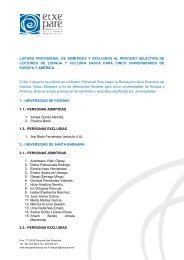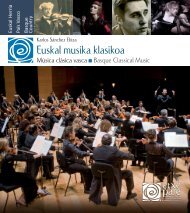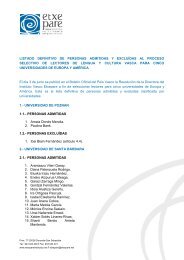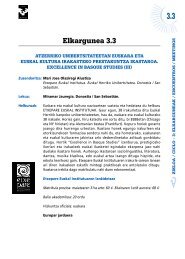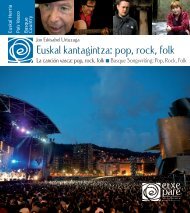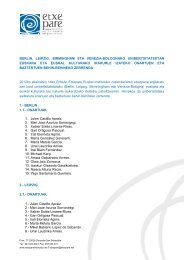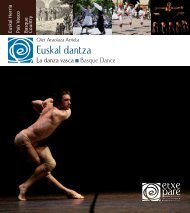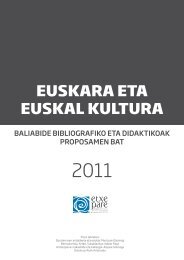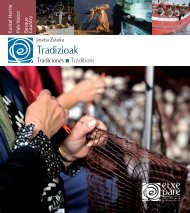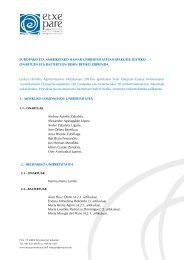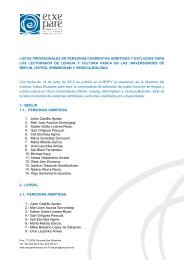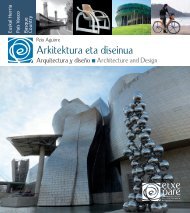XX. mendeko euskal literatura - Etxepare, Euskal Institutua
XX. mendeko euskal literatura - Etxepare, Euskal Institutua
XX. mendeko euskal literatura - Etxepare, Euskal Institutua
Create successful ePaper yourself
Turn your PDF publications into a flip-book with our unique Google optimized e-Paper software.
y espantapájaros (1963). Su obra narrativa se inscribe<br />
dentro de la corriente neorrealista, y describe el<br />
mundo de los desfavorecidos y desamparados.<br />
El nombre de Ramiro Pinilla empezó a sonar con<br />
fuerza en el mundo literario tras hacerse con el Premio<br />
Nadal en 1960 con Las ciegas hormigas. En 2005<br />
empezó a redactar la trilogía Verdes valles, colinas<br />
rojas, compuesta por los títulos La tierra convulsa,<br />
Los cuerpos desnudos y Las cenizas del hierro, un<br />
ambicioso fresco sobre la historia reciente del País<br />
Vasco y del nacionalismo, además de ser un sagaz<br />
retrato de Getxo, su pueblo natal. Pinilla obtuvo el<br />
Premio Euskadi por La tierra convulsa en 2005, y en<br />
2006 recibió el Premio Nacional de Narrativa por Las<br />
cenizas del hierro.<br />
Entre los autores nacidos en las décadas de 1930 y<br />
1930 se encuentran Raúl Guerra Garrido (Madrid<br />
1935), Jorge González Aranguren (San Sebastián,<br />
1938), Ángel García Ronda (San Sebastián, 1939),<br />
Germán Sánchez Espeso (Pamplona, 1940), Rafael<br />
Castellano de la Puente (Deba, 1943), J. J. Rapha<br />
Bilbao (Getxo, 1943), Manuel Blanco Chivite (Madrid,<br />
1945) y Toti Martínez de Lezea (Vitoria-Gasteiz,<br />
1949).<br />
Raúl Guerra Garrido escribió su primera novela,<br />
Ni héroe ni nada, en 1969 y desde entonces lleva<br />
publicadas una veintena de obras. Ganó el Premio<br />
Nadal en 1976 por Lectura insólita de El Capital y<br />
fue finalista del Premio Planeta en 1984 por El año<br />
del Wolfram. En 1987 vio la luz La mar es una mala<br />
mujer, según la crítica su obra más completa, que<br />
posteriormente fue llevada al cine bajo el título Terranova.<br />
La obra narra la lucha de Antxon en contra<br />
del tiempo. La violencia terrorista es uno de sus<br />
grandes temas, en el cual indaga La carta (1990) o<br />
la reciente La soledad del ángel del guarda (2007),<br />
retrato psicológico de un hombre que pasa a ser la<br />
sombra de un profesor amenazado por el terrorismo<br />
y por la que obtuvo el Premio Nacional de las Letras<br />
Españolas en 2006.<br />
(1961), Neutral corner (1962) and Pájaros y espantapájaros<br />
(1963). His narrative work forms part of the<br />
neorealist movement, and describes the world of the<br />
disadvantaged and helpless.<br />
Ramiro Pinilla began to make a name for himself in<br />
the literary world after winning the Nadal Prize in<br />
1960 for Las ciegas hormigas. In 2005 he began to<br />
publish the trilogy Verdes valles, colinas rojas, made<br />
up of the works La tierra convulsa, Los cuerpos desnudos<br />
and Las cenizas del hierro, an ambitious fresco<br />
on the contemporary history of the Basque Country<br />
and nationalism, as well as being a shrewd portrait of<br />
Getxo, his home town. Pinilla won the Euskadi Prize<br />
for Literature for La tierra convulsa in 2005, and in<br />
2006 he recived the Spanish National Prize for Narrative<br />
for Las cenizas del hierro.<br />
Amongst those authors born in the 1930s and 1940s<br />
we might mention Raúl Guerra Garrido (Madrid,<br />
1935), Jorge González Aranguren (Donostia-San Sebastián,<br />
1938), Ángel García Ronda (Donostia-San Sebastián,<br />
1939), Germán Sánchez Espeso (Pamplona-<br />
Iruñea, 1940), Rafael Castellano de la Puente (Deba,<br />
1943), J.J. Rapha Bilbao (Getxo, 1943), Manuel Blanco<br />
Chivite (Madrid, 1945) and Toti Martínez de Lezea<br />
(Vitoria-Gasteiz, 1949).<br />
Raúl Guerra Garrido wrote his first novel, Ni héroe ni<br />
nada, in 1969 and since then has published around<br />
twenty other works. He won the Nadal Prize in 1976 for<br />
Lectura insólita de El Capital and was a finalist in the<br />
Planeta Prize of 1984 for El año del Wolfram. In 1987<br />
he published La mar es una mala mujer, which according<br />
to critics was his most complete work to date,<br />
and which was later made into a film, Terranova. This<br />
work tells the story of the struggle of a character, Antxon,<br />
against time. Terrorist violence is one of his major<br />
subjects, as explored in La carta (1990) and the more<br />
recent La soledad del ángel del guarda (2007), a psychological<br />
portrayal of a man who becomes the shadow<br />
of a professor threatened by terrorism and for which he<br />
received the National Prize of Spanish Letters in 2006.<br />
73



